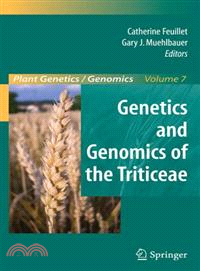Genetics and Genomics of the Triticeae
商品資訊
系列名:Plant Genetics and Genomics: Crops and Models
ISBN13:9780387774886
出版社:Springer Verlag
作者:Catherine Feuillet (EDT); Gary J. Muehlbauer (EDT); Ronald L. Phillips (FRW)
出版日:2008/10/01
裝訂/頁數:精裝/757頁
規格:24.1cm*17.8cm*3.2cm (高/寬/厚)
定價
:NT$ 17500 元若需訂購本書,請電洽客服 02-25006600[分機130、131]。
商品簡介
作者簡介
相關商品
商品簡介
Sequencing of the model plant genomes such as those of A. thaliana and rice has revolutionized our understanding of plant biology but it has yet to translate into the improvement of major crop species such as maize, wheat, or barley. Moreover, the comparative genomic studies in cereals that have been performed in the past decade have revealed the limits of conservation between rice and the other cereal genomes. This has necessitated the development of genomic resources and programs for maize, sorghum, wheat, and barley to serve as the foundation for future genome sequencing and the acceleration of genomic based improvement of these critically important crops. Cereals constitute over 50% of total crop production worldwide (http://www.fao.org/) and cereal seeds are one of the most important renewable resources for food, feed, and industrial raw materials. Crop species of the Triticeae tribe that comprise wheat, barley, and rye are essential components of human and domestic animal nutrition. With 17% of all crop area, wheat is the staple food for 40% of the world’s population, while barley ranks fifth in the world production. Their domestication in the Fertile Crescent 10,000 years ago ushered in the beginning of agriculture and signified an important breakthrough in the advancement of civilization. Rye is second after wheat among grains most commonly used in the production of bread and is also very important for mixed animal feeds. It can be cultivated in poor soils and climates that are generally not suitable for other cereals. Extensive genetics and cytogenetics studies performed in the Triticeae species over the last 50 years have led to the characterization of their chromosomal composition and origins and have supported intensive work to create new genetic resources. Cytogenetic studies in wheat have allowed the identification and characterization of the different homoeologous genomes and have demonstrated the utility of studying wheat genome evolution as a model for the analysis of polyploidization, a major force in the evolution of the eukaryotic genomes. Barley with its diploid genome shows high collinearity with the other Triticeae genomes and therefore serves as a good template for supporting genomic analyses in the wheat and rye genomes. The knowledge gained from genetic studies in the Triticeae has also been used to produce Triticale, the first human made hybrid crop that results from a cross between wheat and rye and combines the nutrition quality and productivity of wheat with the ruggedness of rye. Despite the economic importance of the Triticeae species and the need for accelerated crop improvement based on genomics studies, the size (1.7 Gb for the bread wheat genome, i.e., 5x the human genome and 40 times the rice genome), high repeat content (>80%), and complexity (polyploidy in wheat) of their genomes often have been considered too challenging for efficient molecular analysis and genetic improvement in these species. Consequently, Triticeae genomics has lagged behind the genomic advances of other cereal crops for many years. Recently, however, the situation has changed dramatically and robust genomic programs can be established in the Triticeae as a result of the convergence of several technology developments that have led to new, more efficient scientific capabilities and resources such as whole-genome and chromosome-specific BAC libraries, extensive EST collections, transformation systems, wild germplasm and mutant collections, as well as DNA chips. Currently, the Triticeae genomics "toolbox" is comprised of:- 9 publicly available BAC libraries from diploid (5), tetraploid (1) and hexaploid (3) wheat; 3 publicly available BAC libraries from barley and one BAC library from rye;- 3 wheat chromosome specific BAC libraries;- DNA chips including commercially available first generation chips from AFFYMETRIX containing 55’000 wheat and 22,000 barley genes;- A large number of wheat and barley genetic maps that are s
作者簡介
Catherine Feuillet is research director and leader of the group "Structure, function and evolution of the wheat genomes" at the INRA, Clermont-Ferrand (France). She was educated as a geneticist and molecular biologist and worked for 10 years in Switzerland on the genomics of disease resistance in wheat and barley before moving to France. She is one of the co-chairs of the International Wheat Genome Sequencing Consortium (IWGSC), the International Triticeae Mapping Initiative (ITMI), and the European Triticeae Genomics Initiative (ETGI). Gary J. Muehlbauer is an Associate Professor and Endowed Chair in Molecular Genetics of Crop Improvement in the Department of Agronomy and Plant Genetics at the University of Minnesota. He studied maize genetics during his Ph.D. at the University of Minnesota and his postdoctoral work at the University of California at Berkeley. He has been on the faculty at the University of Minnesota for eleven years working on barley and wheat genomics. He is the vice chair of the International Barley Sequencing Consortium.
主題書展
更多
主題書展
更多書展今日66折
您曾經瀏覽過的商品
購物須知
外文書商品之書封,為出版社提供之樣本。實際出貨商品,以出版社所提供之現有版本為主。部份書籍,因出版社供應狀況特殊,匯率將依實際狀況做調整。
無庫存之商品,在您完成訂單程序之後,將以空運的方式為你下單調貨。為了縮短等待的時間,建議您將外文書與其他商品分開下單,以獲得最快的取貨速度,平均調貨時間為1~2個月。
為了保護您的權益,「三民網路書店」提供會員七日商品鑑賞期(收到商品為起始日)。
若要辦理退貨,請在商品鑑賞期內寄回,且商品必須是全新狀態與完整包裝(商品、附件、發票、隨貨贈品等)否則恕不接受退貨。
























